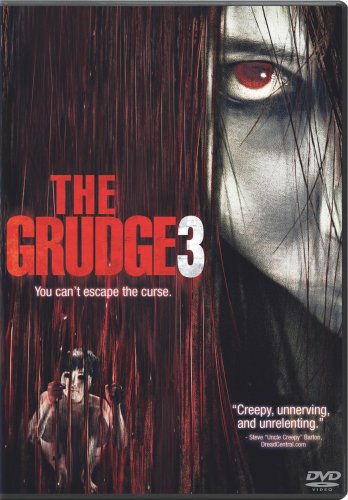 Remember how scared you were when you first saw THE GRUDGE? Want to feel that way again? Well, it’s a good thing home video allows you to pop the 2004 film in the DVD player, because watching THE GRUDGE 3 is not going to invoke any of the atmospheric, irrational thrills you recollect from the older movie. In fact, THE GRUDGE 3 – a low-budget, direct-to-video sequel shot in Bulgaria – is such a dismally spiritless affair that it almost seems deliberately designed to make the disappointing THE GRUDGE 2 look good by comparison.
Remember how scared you were when you first saw THE GRUDGE? Want to feel that way again? Well, it’s a good thing home video allows you to pop the 2004 film in the DVD player, because watching THE GRUDGE 3 is not going to invoke any of the atmospheric, irrational thrills you recollect from the older movie. In fact, THE GRUDGE 3 – a low-budget, direct-to-video sequel shot in Bulgaria – is such a dismally spiritless affair that it almost seems deliberately designed to make the disappointing THE GRUDGE 2 look good by comparison.
In case you don’t remember the ending of the aforementioned GRUDGE 2 (and really, why would you want to?), it relocated the action to Chicago with the obvious intention of setting up future sequels that could abandon the Japanese origins of the story. Living up (or down) to that unpromising premise, GRUDGE 3 is set entirely in Chicago except for one brief scene in Japan that introduces us to Naoko (Emi Ikehata), who in the grand tradition of pointless revelations turns out to be the unlikely sister of Kayako, the angry spirit responsible for the lethal “grudge.”
The great thing about the JU-ON films (the Japanese originals on which THE GRUDGE was based, particularly 2003’s JU-ON: THE GRUDGE) was the way that writer-director Takashi Shimizu abandoned traditional plot structure, offering a series of vignettes that tied together like a twisted tapestry, avoiding the exposition, characterization, and plot mechanics over which so many horror films stumble. THE GRUDGE 3 abandons this lesson in favor of telling a story about an apartment building where the manager is slowly turning homicidal thanks to a ghostly influence; in effect, it has as much in common with THE AMITYVILLE HORROR as THE GRUDGE.
Fortunately for our American victims, after sitting out the events of the previous two films (six, if you count the four Japanese JU-ON titles), Naoko has finally decided it’s time to take action and put her sister’s restless spirit down for good. Why the change of heart? Apparently, as long as Kayako was limited to Japan, it was okay, but it’s a shame on the family for the ghost to be messing with Americans overseas.
What is Naoko going to do? Perform an exorcism, that’s what. This undermines the overwhelming terror of the orignal JU-ON/THE GRUDGE concept – which was that the curse was unstoppable; one you were exposed to it, your fate was sealed. It also moves the already conventional story in an even more conventional direction, with a stranger riding into town to solve the problem.
This disappointing scenario was written, surprisingly enough, by Brad Keene, who scripted two of the best entries in the annual After Dark Hororfest. You really would be better off watching either FROM WITHIN (2008) or THE GRAVEDANCERS (2006). Presumably, executive interference undid him here.
Keene’s writing certainly wasn’t helped by Toby Wilkins’ direction. Having helmed a few “Tales of the Grudge” webisodes to promote THE GRUDGE 2, Wilkins does a poor job of stepping into the director’s shoes. The omnipresent dread that filled Takashi Shimizu’s JU-ON and GRUDGE films is missing from THE GRUDGE 3, replaced with the cliches of bad American horror movies. Even worse, the uncanny, irrational scares have been abandoned in favor of cruder shocks, including a few moments of gratuitous gore. Completely ineffective, these bloody moments merely underline how desperate the director is to deliver anything approaching a scare.
The cast of is mostly forgettable. Genre names Shawnee Smith (SAW) and Marina Sirits (STAR TREK: THE NEXT GENERATION) show up just long enough to get killed off. Aiko Horiuchi, replacing Takako Fuji as Kayako, does a passable imitation, but newcomer Shimba Tsuchiya is too old to play ghost-boy Toshio, who has been recast twice previously to prevent the character from aging on screen. It’s a sign of how careless the custodians of the franchise have become that such an obvious mistake was allowed to slip through.
Perhaps the most perplexing cinematic mystery of the new millenium is why and how Ghosthouse Productions (Sam Raimi’s horror-oriented production company) managed to run their GRUDGE franchise into the depths of the direct-to-video abyss so quickly, going from a blockbuster hit (THE GRUDGE) to a disappointing theatrical sequel (THE GRUDGE 2) to a total DTV disaster (THE GRUDGE 3) in just three easy steps. Really, they couldn’t have failed any more badly, or any faster, if they had tried. (Maybe someone from the Bush administration is working for them?)
Of course, even popular trends can fade fast, and America’s J-Horror remakes and sequels have been waning for awhile now, so it’s tempting to theorize that Ghost House is merely the victim of fading audience interest in a genre that has lost the ectoplasmic power to spook. Has J-Horror given up the ghost? Perhaps.
Or perhaps not. Two new JU-ON sequels made their debut in Japan last month, JU-ON: SHIROI ROJO (“The Grudge: The Old Lady in White”) and JU-ON: KUROI SHOJO (“The Grudge: The Girl in Black”). JU-ON writer-director Takashi Shimizu merely supervised these follow-ups, but the deliciously creepy trailer suggest that the angry spirits of Japanese horror films still have a few scares left in them.
THE GRUDGE 3(2009, direct to video). Directed by Toby Wilkins. Written by Brad Keene, based on characters created by Takashi Shimizu. Cast: Matthew Knight, Shawnee Smith, Mike Straub, Aiko Horiuchi, Shimba Tsuchiya, Emi Ikehata, Takatsuna Mukai, Johanna Braddy, Marina Sirtis.
[serialposts]
Tag: J-Horror
Ju-On: Shiroi Rojo & Kuroi Shojo – Watch the Trailer
American audiences are sick and tired of American J-Horror remakes and sequels, and who can blame them after ONE MISSED CALL, SHUTTER, and especially the dismal directo-to-video disturbance known as THE GRUDGE 3? Yet Japan continues to produce modern kaidan eiga (“ghost story movies”), and the most recent examples look pretty good, judging by the trialer.
JU-ON: SHIROI ROJO (“The Grudge: Old Lady in White”) and JU-ON: KUROI SHOJO (“The Grudge: Girl in Black”) are indirect sequels to four JU-ON films written and directed by Takashi Shimizu, which were remade as THE GRUDGE (2004) with Sara Michelle Gellar. Shimizu is on board as “consulting producer” for both of the new Japanese sequels, and he takes a credit for “original story,” but he turned the actual writing and directing chores over to newcomers, who hopefully will bring some new blood to the franchise while staying true to what made Shimizu’s films so special.
SHIROI ROJO, scripted and directed by Ryuta Miyaka, deals with a high school girl disturbed by visions of her best friend come back from the grave after a murder suicide. KUROI SHOJO, scripted and directed by Mari Asato, is about a girl with a mysterious growth in her body that turns out to be the a “grudge” (or curse) from an unborn baby.
No word on when either or both of these will make it to U.S. shores.
The Uninvited – Blu-ray Review
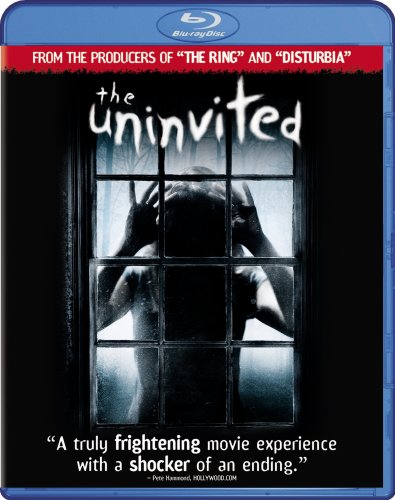 The PG-13 shocker THE UNINVITED snuck through theaters like a cat burglar last year, leaving behind little evidence of its presence other than a few tattered posters hanging from construction site fencing. Not helping the film’s case with genre audiences was its status as yet another remake of an Asian ghost story, this time South Korea’s A Tale of Two Sisters; we’ve had a long-standing knee jerk reaction to this 21st century Hollywood methodology – and not just because of the gaping lack of imagination that it lays bare. From J-horror to K-horror and everything else in-between, the shock implements have lost their sting and feel increasingly trite – not just the distinctive way that otherworldly spirits are depicted, but their jerky movement around the frame made nearly all Asian ghost stories feel like films in the same decades-long series. We haven’t seen the film on which THE UNINVITED is based – a trait that, according to the supplemental features, is shared by the filmmakers.
The PG-13 shocker THE UNINVITED snuck through theaters like a cat burglar last year, leaving behind little evidence of its presence other than a few tattered posters hanging from construction site fencing. Not helping the film’s case with genre audiences was its status as yet another remake of an Asian ghost story, this time South Korea’s A Tale of Two Sisters; we’ve had a long-standing knee jerk reaction to this 21st century Hollywood methodology – and not just because of the gaping lack of imagination that it lays bare. From J-horror to K-horror and everything else in-between, the shock implements have lost their sting and feel increasingly trite – not just the distinctive way that otherworldly spirits are depicted, but their jerky movement around the frame made nearly all Asian ghost stories feel like films in the same decades-long series. We haven’t seen the film on which THE UNINVITED is based – a trait that, according to the supplemental features, is shared by the filmmakers.
After losing her mother in a fire, youngest daughter Anna (Emily Browning) is driven into a deep depression and plagued by nightmares. Released after a lengthy stay at a psychiatric facility (and a suicide attempt), Anna returns home to her sister Alex (Arielle Kebbel) and father (the great David Strathairn) and her mother’s former nurse, Rachel (Elizabeth Banks), who has become her father’s very live-in girlfriend. Tensions between Rachel and the girls are intensified when Anna’s increasingly vivid nightmares include the corpse of her own mother, who seems to be accusing Rachel of her own murder. The girls’ suspicions of Rachel deepen when an investigation into her past reveals a recent name change that may have helped cover up the murder of several children under her care (who also begin to appear in Anna’s dreams, which now seem to be full-fledged psychic visions) . This revelation convinces Anna and Alex that Rachel has her sights set on their father, putting them directly in the path of a potentially psychotic killer.
THE UNINVITED plays out most of its brief running time as if V. C. Andrews had been inspired to fashion a Hammer-style gothic potboiler. In fact, it is difficult while watching the film to resist the urge to mentally recast and relocate the film to better suit those ends. The trend towards younger and younger casting (Miss Browning, who submerges her native Aussie accent admirably, was 19 at the time of shooting and looks significantly younger) invariably robs many of these stories of any real depth before they even leave the starting blocks.
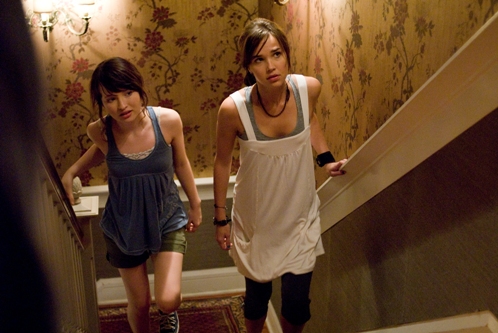
Another hurdle is the fact that there isn’t a likeable character anywhere to be found; in spite of their recent tragedy, it is difficult not to see Alex and Anna as anything other than over-privileged, jerky teens. Strathairn couldn’t give a bad performance on his worst day, but weak writing ties him to a non-existent character who exists only as a plot device programmed to appear every so often to dismiss his daughters’ (somewhat legitimate) concerns and provide the picturesque seaside home where 90% of the film is set. Equally thankless is the ‘evil stepmom’ role given to Banks; an effective comic actress (who was very, very good in The 40 Year Old Virgin) but isn’t very believable as either a live-in nurse or a scheming killer.
Anna’s dreams/visions form the core of the plot, and also give the film its very ‘Asian’ influenced shock effects. There are a few undeniably good moments, but anyone well versed in the genre will have already seen enough broken corpses drag themselves across a floor to fill several lifetimes. There is, as you may have heard, a major plot revelation at THE UNINVITED‘s conclusion that makes its discussion in a spoiler-free environment all but impossible. It is one of those tiresome twists that is supposed to make the audience reevaluate everything that they’ve already seen, but this particular story can’t hold up to that sort of scrutiny and looks to be more a case of the screenwriters painting themselves into a corner and using a hoary device to swing free. It’s strange to feel that a film would have been better had it been less ambitious; THE UNINVITED is a pleasant enough semi-gothic ghost story for the first 70 minutes or so, and a more standard conclusion might have been far more satisfying.
We can’t find too many faults with DreamWorks Blu-Ray edition of THE UNINVITED. Its 1080p picture is lovely to look at, wringing the most out of the cool-toned cinematography. Directors Charles and Thomas Guard have adopted a very clean, unfussy shooting style for the picture that compliments the actresses in particular.
The Dolby TrueHD track is equally strong, punching up the scare effects to the point where we kept the sound too low to hear quiet conversations less we be sent flying off our sofa (or engender anger among close neighbors.)
Special features include “Unlocking the Uninvited” (in HD), a ready-for-HBO EPK featurette, which features enough spoilers in its brief running time to make actually watching the film a moot exercise, although it is particularly funny to hear both the screenwriter and director of a remake insist that they haven’t seen the original South Korean film; the concerned parties all site the plot outline as the reasoning for their interest in the project.
Also present are a handful of deleted scenes and a slightly altered ending, both of which are in HD as well.
[serialposts]
Nobuo Nakagawa to be honored post-humously
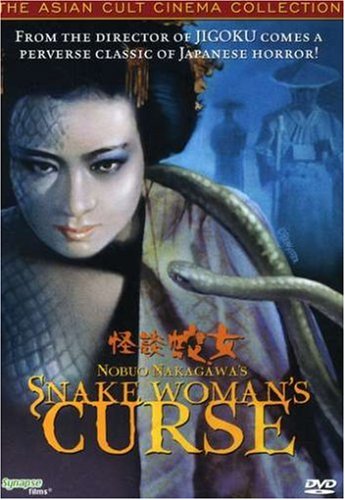 The late Japanese director Nobuo Nakagawa – whose horror films in the ’50s and ’60s laid the groundwork for later movies like RING and JU-ON – will be honored at next year’s Future Film Festival in Venice. Nakagawa’s works include GHOST STORY OF YOTSUYA (based on a classic legend), GHOST CAT MANSION, GHOST STORY OF KASANE SWAMP, SNAKE WOMAN’S CURSE, and the classic JIGOKU – one of the most amazing horror films ever made.
The late Japanese director Nobuo Nakagawa – whose horror films in the ’50s and ’60s laid the groundwork for later movies like RING and JU-ON – will be honored at next year’s Future Film Festival in Venice. Nakagawa’s works include GHOST STORY OF YOTSUYA (based on a classic legend), GHOST CAT MANSION, GHOST STORY OF KASANE SWAMP, SNAKE WOMAN’S CURSE, and the classic JIGOKU – one of the most amazing horror films ever made.
It is hard to overestimate Nakagawa’s influence. On the DVD bonus features for JIGOKU, director Kiyoshi Kurosaw (KAIRO) states that, when he teaches film classes, he avoids showing Nakagawa’s works because he doesn’t want his students to realize how much he owes to Nakagawa.
Also to be honored at the festival is Disney animator Ub Iwerks.
Cybersurfing: Asian Horror Films
 If you’re like me, you probably experience frustration on a weekly if not daily basis when it comes to getting your fix of Asian horror movies. Sure, famous titles like RING and JU-ON are available on DVD if you look hard enough, and a ton of lesser known titles show up on shelves here or there. But a lot of stuff simply isn’t out there – not on Netflix, not at your local Blockbuster, not at your specialty shop (should you be so lucky to have one nearby), maybe not enough on Region 1 DVD at all.
If you’re like me, you probably experience frustration on a weekly if not daily basis when it comes to getting your fix of Asian horror movies. Sure, famous titles like RING and JU-ON are available on DVD if you look hard enough, and a ton of lesser known titles show up on shelves here or there. But a lot of stuff simply isn’t out there – not on Netflix, not at your local Blockbuster, not at your specialty shop (should you be so lucky to have one nearby), maybe not enough on Region 1 DVD at all.
Ergo, you may want to check out this website: www.asian-horror-movies.com, which offers streaming movies online. Their amusing motto, obvously inspired by RING, is “Warning: May Cause Death in Seven Days.”
A quick glance revealed that they have GHOST OF YOTSUYA, the 1959 classic from Nobuo Nakagawa (director of THE SNAKE WOMAN’S CURSE), who is more or less the godfather of the modern Japanese horror film. I have never seen YOTSUYA available anywhere in the U.S., although you might be able to purchase an import VHS or DVD if you look hard enough online.
The streaming video quality looks okay (about VHS level) on my 22-inch flat screen computer monitor, but I doubt it would look great on my new 50-in plasma TV (which will connect to the computer for watching online movies).
If you’re less interested in older classic films, don’t worry. Asian Horror Movies is loaded with more modern titles like A TALE OF TWO SISTERS and PHONE.
Is this a bootleg website? I don’t know. But when you click to view a title, you do have to view an ad first, which suggests that this is a professional website.
J-Horror director wins award – for going mainstream
It’s an old story, but it seems like we’ll never stop hearing it told again: You can wow audiences and even earn a certain cult acclaim by in the horror genre, but it you won’t win awards until you go mainstream; then all the critics who liked your work but didn’t want to bestow accolades on something as disreputable as a horror film can come out of the closet and bestow an award on you, which can be interpreted either as a reward for leaving the genre behind or as a retroactive acknowledgement of all the good work you’ve done in the past. This distinction between successfully scary pop art and seriously respectable cinema was perhaps most vivid in 1993 when Steven Spielberg directed both JURASSIC PARK – which went on to become the biggest box officer grosser ever up to that time – and SCHINDLER’S LIST – which went on to win the Academy Award for Best Picture.
The latest example of this phenomenon is Kiyoshi Kurosawa, director of the influential 2001 J-horror film PULSE (which was remade in America a few years later). Although many of Kurosawa’s films have screened at the Cannes Film Festival, the director just pieced up his first award there – for the non-genre TOKYO SONOTA:
“I have shown films at Cannes many times before,” he said.
“But with Tokyo Sonata I felt that audiences really appreciated the film and found it satisfying. It wasn’t that they saw it as something weird and exclusively Japanese. They could relate to it,” he added.
In a Reuters interview, Kurosawa makes it clear that the genre change was not merely to win awards; like many who toil in horror, he wanted to avoid being typed in the genre:
“I made a lot of horror films, but I wanted to do other things,” the 53-year-old director told Reuters on Thursday. “I didn’t want to be seen as a specialist in that genre.”
RELATED ARTICLES:
-
Review: Pulse
The Ring Companion – Book Review

This 2005 publication is an excellent book that should be on the shelf of every fan of the RING films; in fact, J-Horror fans in general will find it supremely rewarding. Author Denis Meikle explores the RING phenomenon in such depth (the cultural context, the novels, the the adaptations for film and television, the sequels and spin-offs) that his book truly could have been titled “The Essential Ring Companion” without a trace of hubris. Meikle writes with the devotion of a fan and the intellect of a first-rate critic: his love for the subject comes through on every page, yet he never devolves into fan-boy gushing or mindless boosterism; he serves up both praise and criticism, in a fair and reasoned manner, and provides the kind of insights that will tickle the fancy of those who thought they knew everything – only to have their awareness enhanced, brightened by a spark that ignites a new flame in the old embers.
Instead of chapters, Meikle divides his book into a prologue and seven “Days” (based upon the seven-day countdown in the story of RING from when when you see the cursed video to the moment of your death). Although mostly chronological, the text maintains interest by reserving certain details for a more dramatic effect (e.g., the famous ending of RING is not discussed in detail until the final chapter).
Along the way, Meikle covers his topic from every conceivable angle, beginning with the source material by Japanese author Koji Suzuki: three novels (Ring, Spiral, and Loop) and a collection of short stories (Birthday). Meikle seems troubled by Suzuki’s reluctance to commit to all-out supernatural horror (his Ring novels read more like Michael Crichton science fiction than Stephen King horror), but he appreciates their strengths and carefully notes the changes made in the adaptations, the first of which was a 1995 TV movie, RING: KANZENBAN, which spiced up the story with nudity.
Before getting to the more well known film adaptations, he provides a history of Japanese ghosts in legend and literature, along with a look at the ghost stories of British antiquary M.R. James, noting several plot parallels between RING and James story “Casting the Runes” (both feature a supernatural curse with a time limit, for example). This is followed by a look at Japanese horror cinema leading up to the 1998 film version of RING.
These chapters provide much-needed historical context for the RING phenomenon, showing Western readers that the 1998 film did not miraculously arrive out of thin air but was actually a modern reinvention of a long-established form. Nevertheless, Meikle’s attention to detail does get the better of him. Yes, Godzilla films are such a gigantic part of Japanese cinema history that it would be impossible to ignore them, but do we really need twelve pages – in a book about supernatural horror, not science fiction? Meikle is on more solid ground when dealing with classics ghost tales such as KWAIDAN and UGETSU (both adapted from traditional supernatural literature), not to mention Kaneto Shindo’s spooky double feature of ONIBABA and KURONEKO.
Meikle delves into the details of the four Japanese films derived from Suzuki’s books: RING, SPIRAL, RING 2, and RING 0: BIRTHDAY. He explores the way the first of this quartet fused Suzuki’s novel with Japanese folklore and elements borrowed from other horror films (including THE OMEN) to create an all-out modern ghost story that launched a worldwide phenomenon. He then notes the problems that plagued the subsequent films: RING had diverged so much from its source that the adaptation of SPIRAL turned out to be a major disappointment that was soon forgotten, leading to RING 2, an original sequel not based on Suzuki’s work. RING 0, a prequel, borrows the setting and time period from “Lemonheart,” a story in Suzuki’s Birthday anthology, but is essentially an original story that tells us how the young Sadako became the monster we met in RING. From there he moves on to the subsequent television adaptations, inspired by the success of the films, which also led to a South Korean remake of RING, entitled THE RING VIRUS.
Meikle rightly reserves his strongest praise for RING, noting the “palpable atmosphere of dread” that builds cumulatively throughout the running time. He dissects the problems with the two sequels but overpraises the prequel as “almost a classic in its own right” when it is at most a mildly interest addendum to the RING mythology. Meikle also accurately notes that South Korea’s THE RING VIRUS is much more faithful to the book than RING, but he takes the point a bit too far, arguing that RING VIRUS is not a remake of RING at all, despite the fact that several major inventions from the Japanese film recur in the Korean version (the protagonist is a single mother, not a married father, and the ghost of the Sadako surrogate, here named Eun-suh, emerges from a television at the end).
Meikle then rightfully trashes the 2002 American remake of RING, titled THE RING, along with its 2005 sequel THE RING TWO. This is followed by a chapter that examines the wave of J-horror films that followed in RING’s wake. As with the chapters on Japanese literature and Japanese horror films, this is an extra-added pleasure that makes The Ring Companion more than a quick knock-off, providing a broader view of the subject by exploring its repercussions on the films that followed. Meikle plows through dozens of titles, offering well-deserved praise for the more well-known ones (e.g., JU-ON, THE EYE, A TALE OF TWO SISTERS), while also singling out some lesser known lights such as Byeong-ki Ahn’s PHONE (2002), which he calls “thoroughly derivative but no less involving for all of that.”
In the Chapter titled “Day Seven,” Meikle examines the show-stopping finale of RING – one of the great horror sequences ever filmed – and then compares it with that of the various other adaptations, remakes, and sequels, which inevitably come up short.
In a final epilogue, Meikle waxes poetic about the RING phenomenon, noting the decline of American horror films into formulaic franchises. There is no doubt that the 1998 movie gave the genre a much-needed shot in the arm, inspiring a memorable trend that yielded several exciting movies. Without resorting to a heavy-handed hatchet job, Meikle makes his point well, noting the sad irony that the ghostly Sadako herself ultimately served as the inspiration for the formulaic American films, but that the integrity of the original film lives on.
If there is one regret you will have after finishing the book (besides the obvious one of wanting the reading experience to go on even longer), it is the absence of an index that would help you return to specific points on which you wish to refresh your memory. With so much information on so many different films and books condensed into nine chapters (counting the prologue and epilogue), finding your way back to discussion of a certain title can be a game of hide-and-seek. The only solution for it is to re-read the entire text from beginning to end -a proposal that is hardly unwelcome.
Ju-on, The Grudge (2003) – Film & DVD Review
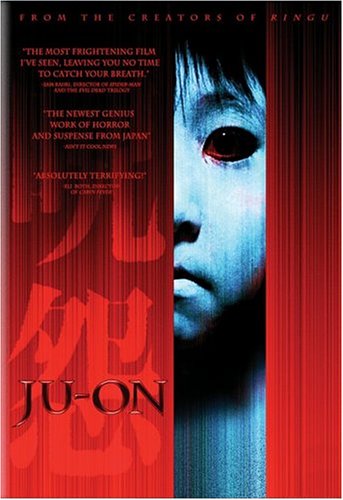 Recall your worst nightmares as a child: your fear of the dark, of being alone in bed at night, of shadows without substance lurking in corners, beneath the bed, outside your door, or in your closet. Remember the creaking floorboards, the rustle of wind or the moan of some animal – a cat, perhaps? – which led you to believe that you were no longer alone, that something tangible was there with you, about to manifest itself before your frightened senses. Now imagine this fear captured on celluloid and presented to you with all the evocative power of your childhood nightmares – only now the nightmare seems utterly convincing, because you know you are awake, and utterly inescapable, because it can follow you anywhere: in attics, down stairs, along corridors, through doors, even into that one place you felt absolutely safe as a child – beneath the bed covers. This is the essence of horror captured in JU-ON: THE GRUDGE, Continue reading “Ju-on, The Grudge (2003) – Film & DVD Review”
Recall your worst nightmares as a child: your fear of the dark, of being alone in bed at night, of shadows without substance lurking in corners, beneath the bed, outside your door, or in your closet. Remember the creaking floorboards, the rustle of wind or the moan of some animal – a cat, perhaps? – which led you to believe that you were no longer alone, that something tangible was there with you, about to manifest itself before your frightened senses. Now imagine this fear captured on celluloid and presented to you with all the evocative power of your childhood nightmares – only now the nightmare seems utterly convincing, because you know you are awake, and utterly inescapable, because it can follow you anywhere: in attics, down stairs, along corridors, through doors, even into that one place you felt absolutely safe as a child – beneath the bed covers. This is the essence of horror captured in JU-ON: THE GRUDGE, Continue reading “Ju-on, The Grudge (2003) – Film & DVD Review”
Death Note – Live-Action Version of the Popular Manga
 Once upon a time there was a little eight-volume Japanese manga that was very popular. It was so popular in fact that the powers that be decided there should be a live-action version (and a sequel) of it. And thus it came to be so.
Once upon a time there was a little eight-volume Japanese manga that was very popular. It was so popular in fact that the powers that be decided there should be a live-action version (and a sequel) of it. And thus it came to be so.
The end? Oh, contraire, my friends. DEATH NOTE (DESU NOTO) made a very solid $22,000,000 at the Japanese box-office and its sequel, DEATH NOTE 2, made an even heftier $41,000,000. Then there was the little spin-off called L: CHANGE THE WORLD (directed by Hideo Nakata, who directed the original RINGU and the U.S.’s THE RING 2), which grossed $29,000,000. These dollar amounts may not seem all that huge in comparison to U.S. box-office figures, but they’re mighty big in Japan. DEATH NOTE and DEATH NOTE 2 were numbers 17 and 10 respectably at the Japanese box-office in 2006 and L is number 3 in 2008 at the time of this writing. Continue reading “Death Note – Live-Action Version of the Popular Manga”
Top 20 Chick Flick Horror Movies
So, you’re a horror movie maniac. You just can’t get enough of ’em. You love the thrill of fear, the scream of terror, the sight of blood. But you have a problem: Your boxed set of BLIND DEAD movies does not enamor your girlfriend. Your Lucio Fulci collection does not send your paramour swooning with rapture. Your unrated torture porn DVDs do not arouse interest. The midnight movie screening of GRINDHOUSE does not inspire romantic fantasies. The latest French gore-fest does not excite erotic intrigue. If anything, the woman in your life is wondering whether you’re a latent serial killer whose interest in the female body does not extend beyond seeing it torn to pieces. You are faced with a dreadful dilemma: either continue to alienate your significant other or stuff those video nasties in the back of the closet along with the real pornography and suffer through endless nights of watching mind-numbingly boring chick flicks like BED OF ROSES (a fate that frightens you far more than anything in your horror collection). Well, lucky for you, we’re here to save the day. You see, there is a way to share your love of the horror genre with a psychologically stable female partner who is not interested in watching an endless stream of blood gushing across the screen. Believe it or not, there are “chick flick” horror movies. They may not be as intense and hardcore as some of your favorite splatter flicks, but they are quite good in their own right, with plenty of appeal to both men and women. Below, we will provide our list of the Top 20 Best Chick Flick Horror Movies.
NOTE: We have more or less listed the films in order of their female appeal, which means that the top-ranked films may not be the most frightening. The first ten tend to emphasize romantic elements of the sort that might be found in a mainstream “chick flick.” The remaining ten simply feature strong female leads.
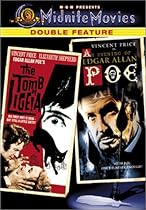 1. TOMB OF LIGEIA (1964). This adaptation of Edgar Alan Poe’s “Ligeia,” features Vincent Price as a man obsessed with the fear that his late wife will return from the grave to haunt him. Although technically too old for role, which was written as a young romantic lead, Price is wonderful as the doomed widower; with a little assist from the makeup department, he conveys the necessary mystique. Lady Rowena (Elizabeth Shepherd) meets and falls in love with him, inspiring him to overcome his fear and marry her. The story is told from Rowena’s point of view, as she is intrigued and enamored by this brooding, mysterious man, only to learn that the dark secret hanging over him will not easily be dispelled. Thanks to a strong performance by Shepherd, working from a great script by Robert Towne, Rowena emerges as one of cinema’s strongest leading ladies – willful and intelligent, she risks her life to drag her husband from the grip of the late Lady Ligeia. The horror element is very muted; the emphasis is on the doomed romance between the two lovers. A moody masterpiece, the film’s fear factor is mostly implied; director Roger Corman includes a few jump scares (the sudden snarl of a cat) and some hypnotic dream sequences, creating an almost surreal sense of dread the relies on Gothic atmopshere more than on-screen violence. In short, this Gothic Romance is the perfect date night rental: you can enjoy the “Gothic,” and she will enjoy the “Romance.”
1. TOMB OF LIGEIA (1964). This adaptation of Edgar Alan Poe’s “Ligeia,” features Vincent Price as a man obsessed with the fear that his late wife will return from the grave to haunt him. Although technically too old for role, which was written as a young romantic lead, Price is wonderful as the doomed widower; with a little assist from the makeup department, he conveys the necessary mystique. Lady Rowena (Elizabeth Shepherd) meets and falls in love with him, inspiring him to overcome his fear and marry her. The story is told from Rowena’s point of view, as she is intrigued and enamored by this brooding, mysterious man, only to learn that the dark secret hanging over him will not easily be dispelled. Thanks to a strong performance by Shepherd, working from a great script by Robert Towne, Rowena emerges as one of cinema’s strongest leading ladies – willful and intelligent, she risks her life to drag her husband from the grip of the late Lady Ligeia. The horror element is very muted; the emphasis is on the doomed romance between the two lovers. A moody masterpiece, the film’s fear factor is mostly implied; director Roger Corman includes a few jump scares (the sudden snarl of a cat) and some hypnotic dream sequences, creating an almost surreal sense of dread the relies on Gothic atmopshere more than on-screen violence. In short, this Gothic Romance is the perfect date night rental: you can enjoy the “Gothic,” and she will enjoy the “Romance.”
 2. I WALKED WITH A ZOMBIE (1943). Producer Val Lewton famously called this movie “Jane Eyre in the West Indies.” He may have been joking, but the statement was accurate enough in its way. The story follows a nurse named Betsy (Frances Dee) who gets a job on a plantation tending the brain-dead wife of her employer Paul (Tom Conway). The wife may or may not be a zombie (the film is deliberately ambiguous on this point); either way, her presence is a living a reminder of ugly family secrets that Paul would rather forget. Betsy falls in love with him, of course, but she sublimates her desire by trying to cure Paul’s wife, taking her to a voodoo ceremony. The attempt backfires: the locals are terrified of the zombie woman and want to destroy her. Atypically for the horror genre, the characterization and performances outweigh the horror; Director Jacques Tourner presents the horror almost entirely in terms of atmosphere, creating a dream-like world in which science and the supernatural vie for acceptance, but ultimately, the voodoo element is a backdrop for the love story between Betsy and Paul, with her in the Jane Ayre role and him as the Byronic Rochester substitute. Best of all, the lovers actually get together and (presumably) live happily ever after.
2. I WALKED WITH A ZOMBIE (1943). Producer Val Lewton famously called this movie “Jane Eyre in the West Indies.” He may have been joking, but the statement was accurate enough in its way. The story follows a nurse named Betsy (Frances Dee) who gets a job on a plantation tending the brain-dead wife of her employer Paul (Tom Conway). The wife may or may not be a zombie (the film is deliberately ambiguous on this point); either way, her presence is a living a reminder of ugly family secrets that Paul would rather forget. Betsy falls in love with him, of course, but she sublimates her desire by trying to cure Paul’s wife, taking her to a voodoo ceremony. The attempt backfires: the locals are terrified of the zombie woman and want to destroy her. Atypically for the horror genre, the characterization and performances outweigh the horror; Director Jacques Tourner presents the horror almost entirely in terms of atmosphere, creating a dream-like world in which science and the supernatural vie for acceptance, but ultimately, the voodoo element is a backdrop for the love story between Betsy and Paul, with her in the Jane Ayre role and him as the Byronic Rochester substitute. Best of all, the lovers actually get together and (presumably) live happily ever after.
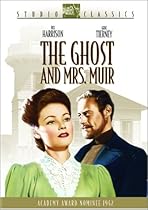 3. THE GHOST AND MRS MUIR (1947). This classic is much more romantic-comedy than horror, but the early scenes – when Mrs. Muir (Gene Tierney) moves into the old house and realizes it is haunted by the ghost of an old sea captain (Rex Harrison) are as effective as any genuine haunted-house movie. The ghost’s first appearance – a shadowy, out-of-focus silhouette – sends a shiver or two down the spine, and his later full-blown revelation -when Mrs. Muir lights and candle, revealing him standing next to her – is a genuine shock. After this, the film segues into a love story levened with humor, but Tierney and Harrison are absolutely wonderful, and the film will charm the woman in your life – and entertain you as well.
3. THE GHOST AND MRS MUIR (1947). This classic is much more romantic-comedy than horror, but the early scenes – when Mrs. Muir (Gene Tierney) moves into the old house and realizes it is haunted by the ghost of an old sea captain (Rex Harrison) are as effective as any genuine haunted-house movie. The ghost’s first appearance – a shadowy, out-of-focus silhouette – sends a shiver or two down the spine, and his later full-blown revelation -when Mrs. Muir lights and candle, revealing him standing next to her – is a genuine shock. After this, the film segues into a love story levened with humor, but Tierney and Harrison are absolutely wonderful, and the film will charm the woman in your life – and entertain you as well.
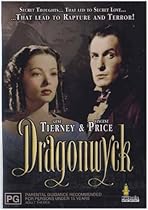 4. DRAGONWYCK (1946). This Gothic-Mystery-Romance features both Gene Tierney and Vincent Price; in many ways, it predates Price’s later TOMB OF LIGEIA, and it was filmed when he was still young enough to play a leading man. More important, this was before he had earned a reputation for screen villainy, so the horrible revelations about his character come as a complete surprise, instead of being telegraphed (as they are in LIGEIA). Price plays the wealthy Nicholas Van Ryn, who sweeps the lovely Miranda Wells (Tierney) off her feet and takes her as his bride to his ancestral estate of Dragonwyck. Miranda’s happiness is soon marred by strange noises in the night and other dark forebodings. Eventually we realize that Nicholas is interested in her only as a means of producing an heir to continue the family line, and if she fails in that duty, he may have to do away with her (as he did his previous wife) and find a replacement. It’s a bit of a stretch to call this a “horror” film, but it is steeped in Gothic atmosphere. Tierney, as always, is a captivating presence, and the romantic chemistry between her and Price is engaging, even if it eventually turns sour. If you like this film, you might also try REBECCA, the 1940 Alfred Hitchcock film starring Laurence Olivier and Joan Fontaine, with Judith Anderson as the wonderfully wicked servant Mrs. Danvers. It’s another Gothic Melodrama – not an outright horror film, but filled with mystery and romance that plays well with both male and female viewers.
4. DRAGONWYCK (1946). This Gothic-Mystery-Romance features both Gene Tierney and Vincent Price; in many ways, it predates Price’s later TOMB OF LIGEIA, and it was filmed when he was still young enough to play a leading man. More important, this was before he had earned a reputation for screen villainy, so the horrible revelations about his character come as a complete surprise, instead of being telegraphed (as they are in LIGEIA). Price plays the wealthy Nicholas Van Ryn, who sweeps the lovely Miranda Wells (Tierney) off her feet and takes her as his bride to his ancestral estate of Dragonwyck. Miranda’s happiness is soon marred by strange noises in the night and other dark forebodings. Eventually we realize that Nicholas is interested in her only as a means of producing an heir to continue the family line, and if she fails in that duty, he may have to do away with her (as he did his previous wife) and find a replacement. It’s a bit of a stretch to call this a “horror” film, but it is steeped in Gothic atmosphere. Tierney, as always, is a captivating presence, and the romantic chemistry between her and Price is engaging, even if it eventually turns sour. If you like this film, you might also try REBECCA, the 1940 Alfred Hitchcock film starring Laurence Olivier and Joan Fontaine, with Judith Anderson as the wonderfully wicked servant Mrs. Danvers. It’s another Gothic Melodrama – not an outright horror film, but filled with mystery and romance that plays well with both male and female viewers.
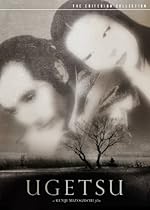 5. UGETSU (1953). Director Kenji Mizoguchi’s period piece, detailing the impact of civil war on two married couples, flirts with the horror genre in several scenes, ultimately turning into a ghost story. There are no overt shocks, but there are some wonderfully eerie moments when a husband realizes he is consorting with a ghost. The overall feeling is one of sorrow more than scares. The movie is ultimately about the price that women pay while their men try to achieve glory and honor during wartime. The result is a real tear-jerker that will have your girlfriend reaching for the tissue box and marveling at what a sensitive soul you are, while you enjoy the ghostly apparitions.
5. UGETSU (1953). Director Kenji Mizoguchi’s period piece, detailing the impact of civil war on two married couples, flirts with the horror genre in several scenes, ultimately turning into a ghost story. There are no overt shocks, but there are some wonderfully eerie moments when a husband realizes he is consorting with a ghost. The overall feeling is one of sorrow more than scares. The movie is ultimately about the price that women pay while their men try to achieve glory and honor during wartime. The result is a real tear-jerker that will have your girlfriend reaching for the tissue box and marveling at what a sensitive soul you are, while you enjoy the ghostly apparitions.
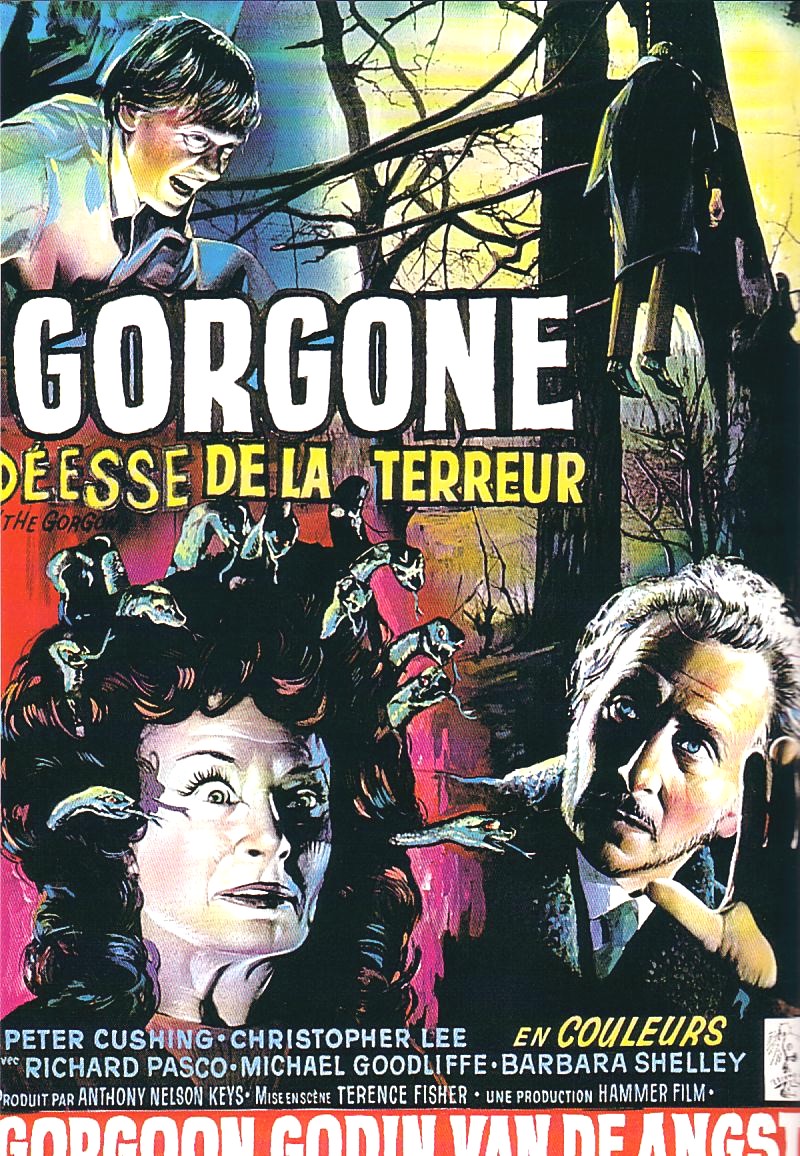 6. THE GORGON (1964). This is not the most effective Hammer horror film in terms of providing scares, but that is only because the emphasis is on romance. The film is a doomed love story about a young student named (Richard Pasco) who comes to a village where a monster is petrifying its victims. After a close encounter with the Gorgon, Paul is nursed back to health by Carla (Barbara Shelley) and falls in love with her. Carla, although she returns his affection, is bound by some dark power over her; eventually, we realize that during the full moon, she becomes the Gorgon. The dynamic acting duo of Peter Cushing and Christopher Lee are on hand as a doctor and a professor, each separately trying to solve the problem, but ultimately there is no hope for Carla or Paul. The film’s greatest achievement is that its horror effects are orchestrated for their emotional impact: this isn’t a movie that has you screaming in terror but weeping in sadness over the plight of the young lovers. The finale will have you and your lady-friend exchanging bodily fluids, but they will be tears of sadness.
6. THE GORGON (1964). This is not the most effective Hammer horror film in terms of providing scares, but that is only because the emphasis is on romance. The film is a doomed love story about a young student named (Richard Pasco) who comes to a village where a monster is petrifying its victims. After a close encounter with the Gorgon, Paul is nursed back to health by Carla (Barbara Shelley) and falls in love with her. Carla, although she returns his affection, is bound by some dark power over her; eventually, we realize that during the full moon, she becomes the Gorgon. The dynamic acting duo of Peter Cushing and Christopher Lee are on hand as a doctor and a professor, each separately trying to solve the problem, but ultimately there is no hope for Carla or Paul. The film’s greatest achievement is that its horror effects are orchestrated for their emotional impact: this isn’t a movie that has you screaming in terror but weeping in sadness over the plight of the young lovers. The finale will have you and your lady-friend exchanging bodily fluids, but they will be tears of sadness.
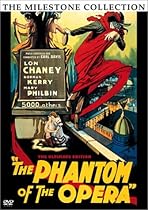 7. THE PHANTOM OF THE OPERA (1925). This famous tale of the deformed mystery man lurking beneath the Paris Opera House is now considered a horror film, but in its day it was more of a mystery-thriller-romance. Erik the Phantom (Lon Chaney) delivers a series of frights (including the famous unmasking of his horrifying visage), but the story is really about his hopeless love for the young and beautiful opera singer Christine (Mary Philbin). The style of this old silent film is dated and stagy, but Chaney keeps it interesting; also, the sets and photography capture the right atmosphere – part horror and part fairy tale – creating the perfect setting for the this variation on “Beauty and the Beast,” with the monster evoking sympathy because of the tender emotions hiding behind his ugly countenance. There have been several remakes. The 1962 version is perhaps even more of a chick flick in that it de-emphasizes the horror element and purifies the Phantom (Herbert Lom)’s motives: he’s no longer interested in Christine sexually, only spiritually. The result yields few frights, but the film possesses a tender quality rare in the horror genre – which should increase its appeal to the distaff side of the audience.
7. THE PHANTOM OF THE OPERA (1925). This famous tale of the deformed mystery man lurking beneath the Paris Opera House is now considered a horror film, but in its day it was more of a mystery-thriller-romance. Erik the Phantom (Lon Chaney) delivers a series of frights (including the famous unmasking of his horrifying visage), but the story is really about his hopeless love for the young and beautiful opera singer Christine (Mary Philbin). The style of this old silent film is dated and stagy, but Chaney keeps it interesting; also, the sets and photography capture the right atmosphere – part horror and part fairy tale – creating the perfect setting for the this variation on “Beauty and the Beast,” with the monster evoking sympathy because of the tender emotions hiding behind his ugly countenance. There have been several remakes. The 1962 version is perhaps even more of a chick flick in that it de-emphasizes the horror element and purifies the Phantom (Herbert Lom)’s motives: he’s no longer interested in Christine sexually, only spiritually. The result yields few frights, but the film possesses a tender quality rare in the horror genre – which should increase its appeal to the distaff side of the audience.
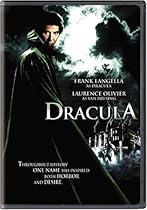 8. DRACULA (1979). There has always been a certain sexual innuendo underlying the Dracula myth, with the mysterious, dark, foreign stranger sneaking into the bedrooms of virginal British ladies. Bela Lugosi played up the foreign mystique, and Christopher Lee emphasized the sexual aggression, but Frank Langella turned the Count into a romantic anti-hero, dashing and seductive, who not only lusts for women (their bodies and their blood) but loves Lucy(Kate Nelligan) for her spirit and intelligence. In 1992, BRAM STOKER’S DRACULA, tries to emphasize the romance even more, but director Francis Ford Coppola fumbles, turning the story into an overwrought teen romance better suited to an episode of JERRY SPRINGER (vampires – and the women who love them).
8. DRACULA (1979). There has always been a certain sexual innuendo underlying the Dracula myth, with the mysterious, dark, foreign stranger sneaking into the bedrooms of virginal British ladies. Bela Lugosi played up the foreign mystique, and Christopher Lee emphasized the sexual aggression, but Frank Langella turned the Count into a romantic anti-hero, dashing and seductive, who not only lusts for women (their bodies and their blood) but loves Lucy(Kate Nelligan) for her spirit and intelligence. In 1992, BRAM STOKER’S DRACULA, tries to emphasize the romance even more, but director Francis Ford Coppola fumbles, turning the story into an overwrought teen romance better suited to an episode of JERRY SPRINGER (vampires – and the women who love them).
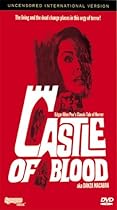 9. CASTLE OF BLOOD (1964). Allegedly based on the work of Edgar Alan Poe, this Italian Gothic horror story tells of Alan, a reporter who wagers he can spend a night alone in a haunted castle. He meets a variety of spooks, including a very alluring one named Elizabeth (played by Barbara Steele, the Queen of Horror). They fall in love, but being – literally – from two different worlds, they cannot stay together, or so it seems. As daylight draws near, the other ghosts come seeking the young man’s blood; Elizabeth tries to lead him to safety, but he dies on the verge of escape. The seemingly downbeat ending is actually a triumph of love over death. As the camera pans up to the sunlight, we hear the disembodied spirits of Alan and Elizabeth conversing, and we know that they are now together for eternity – the ultimate romantic fantasy. Steele also starred in a dual role as an innocent princess and a vampire-witch in the 1960 classic BLACK SUNDAY – a much more effective horror film that also has a strong romantic element, thanks to the chemistry between the princess and a young doctor (John Richardson) who seeks to save her from the vampire.
9. CASTLE OF BLOOD (1964). Allegedly based on the work of Edgar Alan Poe, this Italian Gothic horror story tells of Alan, a reporter who wagers he can spend a night alone in a haunted castle. He meets a variety of spooks, including a very alluring one named Elizabeth (played by Barbara Steele, the Queen of Horror). They fall in love, but being – literally – from two different worlds, they cannot stay together, or so it seems. As daylight draws near, the other ghosts come seeking the young man’s blood; Elizabeth tries to lead him to safety, but he dies on the verge of escape. The seemingly downbeat ending is actually a triumph of love over death. As the camera pans up to the sunlight, we hear the disembodied spirits of Alan and Elizabeth conversing, and we know that they are now together for eternity – the ultimate romantic fantasy. Steele also starred in a dual role as an innocent princess and a vampire-witch in the 1960 classic BLACK SUNDAY – a much more effective horror film that also has a strong romantic element, thanks to the chemistry between the princess and a young doctor (John Richardson) who seeks to save her from the vampire.
10. THE GIRL IN A SWING (1989). This small independent film, based on the novel by Richard Adams, is essentially a love story about a repressed British man (Rupert Frazer), who meets and marries a mysterious German girl named (Meg Tilly). In the great tradition of tragic romances, the marraige is doomed, but only gradually do hints of a haunting arise, related to some guilty secret of Karin’s. The relentless ghost is seldom seen, keeping the horror content to a minimum; instead, the film focuses on the tragedy of the relationship. Though far from a masterpiece, the film works in its own way, achieving its emotional effects with far less cheesy manipulation than LOVE STORY – and it has a ghost, too, so what more do you want?
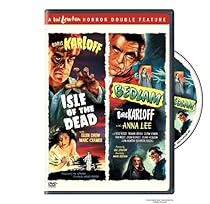 11. BEDLAM (1946). Another Val Lewton production, this period piece tells of an arrogant woman (Anna Lee) who is unfairly confined to the infamous English asylum. Although the official star is Boris Karloff (FRANKENSTEIN) as the asylum’s evil overlord, Lee gives a great performance in what is truly the lead role: charting her character’s arc from selfishness to concern for the other patients, she emerges as one of the great female characters in the history of horror cinema.
11. BEDLAM (1946). Another Val Lewton production, this period piece tells of an arrogant woman (Anna Lee) who is unfairly confined to the infamous English asylum. Although the official star is Boris Karloff (FRANKENSTEIN) as the asylum’s evil overlord, Lee gives a great performance in what is truly the lead role: charting her character’s arc from selfishness to concern for the other patients, she emerges as one of the great female characters in the history of horror cinema.
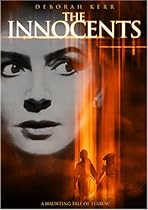 12. THE INNOCENTS (1960). This excellent English ghost story, based on Henry James’ The Turn of the Screw, stars Deborah Kerr as Miss Giddens, a governess put in charge of two children living in a secluded mansion. She gradually comes to believe that the house is haunted and that the children are in league with the ghosts. The film is deliberately ambiguous: are the ghosts real or is Miss Giddens imagining them? Either way, it is a wonderful portrait of a woman desperately dealing with a horrible situation without a hero to ride in and rescue her.
12. THE INNOCENTS (1960). This excellent English ghost story, based on Henry James’ The Turn of the Screw, stars Deborah Kerr as Miss Giddens, a governess put in charge of two children living in a secluded mansion. She gradually comes to believe that the house is haunted and that the children are in league with the ghosts. The film is deliberately ambiguous: are the ghosts real or is Miss Giddens imagining them? Either way, it is a wonderful portrait of a woman desperately dealing with a horrible situation without a hero to ride in and rescue her.
 13. THE HAUNTING (1963). Another great ghost story, this one portrays an attempt to investigate the “Mount Everest of Haunted Houses.” Based on Shirley Jackson’s The Haunting of Hill House, the story is told from the point of view of Nell (Julie Harris), a fragile young woman whose desperate need for love and acceptance lures her to succumb to Hill House. An effective scare-fest, this film is also a great character study that should appeal to female viewers. Men can enjoy the scares and the presence of Claire Bloom as Theo, whom the film none too subtly insinuates is a lesbian. The 1974 film THE LEGEND OF HELL HOUSE deals with a similar situation: a team of two men and two women attempt a sceintific investigation of a haunted house. The scares are a bit more overt, and the psychology less in depth, but the film retains some “chick flick” interest thanks to the performances of Pamela Franklyn and Gayle Hunnicutt, who help create characters that the women in the audience can identify with.
13. THE HAUNTING (1963). Another great ghost story, this one portrays an attempt to investigate the “Mount Everest of Haunted Houses.” Based on Shirley Jackson’s The Haunting of Hill House, the story is told from the point of view of Nell (Julie Harris), a fragile young woman whose desperate need for love and acceptance lures her to succumb to Hill House. An effective scare-fest, this film is also a great character study that should appeal to female viewers. Men can enjoy the scares and the presence of Claire Bloom as Theo, whom the film none too subtly insinuates is a lesbian. The 1974 film THE LEGEND OF HELL HOUSE deals with a similar situation: a team of two men and two women attempt a sceintific investigation of a haunted house. The scares are a bit more overt, and the psychology less in depth, but the film retains some “chick flick” interest thanks to the performances of Pamela Franklyn and Gayle Hunnicutt, who help create characters that the women in the audience can identify with.
 14. THE OTHERS (2001). Intentionally molded in the tradition of THE INNOCENTS, this ghost story features another strong female lead, in this case played by the talented Nicole Kidman. The scares are extremely effective, but what holds interest from beginning to end is the focus on Kidman’s Grace Stewart as she desperately tries to protect her children from the mysterious forces at work in their isolated house.
14. THE OTHERS (2001). Intentionally molded in the tradition of THE INNOCENTS, this ghost story features another strong female lead, in this case played by the talented Nicole Kidman. The scares are extremely effective, but what holds interest from beginning to end is the focus on Kidman’s Grace Stewart as she desperately tries to protect her children from the mysterious forces at work in their isolated house.
 15. THE ORPHANAGE (2007). Belen Rueda stars as Laura, a woman whose son goes missing in their new house, possibly abducted by ghosts. As with the three previous entries on our list, this film orchestrates a series of unnerving spooky encounters while focusing on the drama of the woman trying to deal with them. There is also a strong maternal element that plays well with women. Although vulnerable, Laura is not a Scream Queen or a victim; she’s not even the traditional “Final Girl” who survives and triumphs. She’s a complex, damaged woman who keeps going even when pushed to extremes. The film was executive produced by Guillermo Del Toro, whose PAN’S LABYRINTH and THE DEVIL’S BACKBONE may also appeal to women, because of their portrait of childhood innocence menaced by adult horrors, with empahsis on emotional content.
15. THE ORPHANAGE (2007). Belen Rueda stars as Laura, a woman whose son goes missing in their new house, possibly abducted by ghosts. As with the three previous entries on our list, this film orchestrates a series of unnerving spooky encounters while focusing on the drama of the woman trying to deal with them. There is also a strong maternal element that plays well with women. Although vulnerable, Laura is not a Scream Queen or a victim; she’s not even the traditional “Final Girl” who survives and triumphs. She’s a complex, damaged woman who keeps going even when pushed to extremes. The film was executive produced by Guillermo Del Toro, whose PAN’S LABYRINTH and THE DEVIL’S BACKBONE may also appeal to women, because of their portrait of childhood innocence menaced by adult horrors, with empahsis on emotional content.
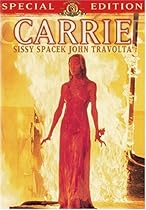 16. CARRIE (1976). Despite director Brian DePalma’s reputation as a cinematic misogynist, this hit horror film features two actresses (Sissy Spacek and Piper Laurie) in strong roles, giving Oscar-nominated performances. This is more a high-school horror film than a chick flick, but it captures a sense of ordinary people living in a world we all recognize, and despite the horrible vengeance she ultimately unleashes on her tormentors, Carrie remains a sympathetic character that women – and men – can relate to.
16. CARRIE (1976). Despite director Brian DePalma’s reputation as a cinematic misogynist, this hit horror film features two actresses (Sissy Spacek and Piper Laurie) in strong roles, giving Oscar-nominated performances. This is more a high-school horror film than a chick flick, but it captures a sense of ordinary people living in a world we all recognize, and despite the horrible vengeance she ultimately unleashes on her tormentors, Carrie remains a sympathetic character that women – and men – can relate to.
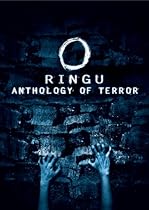 17 RING 0: BIRTHDAY (2000). This prequel to 1998’s RING (the film that launches the recent J-Horror wave) covers some of the same territory as CARRIE. Set in a small acting troup, it tells the story of Sadako (Yukie Nakama), a young misfit with strange powers, who is tormented by her fellow thespians until she turns the tables. Presenting a far more sympathetic portrait of Sadako than seen in the other RING films, this is pretty much a bust as a horror film, but it is an interesting portrait of a sad, lonely, mixed up girl trying to fit in. In general, ghost movies from Japan and other Asian nations should find favor with female viewers: they tend to feature female characters as the protagonists, and the restless spirits are almost always women, their power in death redressing the imbalance they suffered during their lives under a patriarchal culture. Besides RING, check out PHONE, THE EYE, JU-ON: THE GRUDGE, and SHUTTER.
17 RING 0: BIRTHDAY (2000). This prequel to 1998’s RING (the film that launches the recent J-Horror wave) covers some of the same territory as CARRIE. Set in a small acting troup, it tells the story of Sadako (Yukie Nakama), a young misfit with strange powers, who is tormented by her fellow thespians until she turns the tables. Presenting a far more sympathetic portrait of Sadako than seen in the other RING films, this is pretty much a bust as a horror film, but it is an interesting portrait of a sad, lonely, mixed up girl trying to fit in. In general, ghost movies from Japan and other Asian nations should find favor with female viewers: they tend to feature female characters as the protagonists, and the restless spirits are almost always women, their power in death redressing the imbalance they suffered during their lives under a patriarchal culture. Besides RING, check out PHONE, THE EYE, JU-ON: THE GRUDGE, and SHUTTER.
 18. ONIBABA (1964). This black-and-white Japanese horror classic has few traditional chick flick elements, but it focuses on two women in the lead roles. Like UGETSU, it portrays the suffering of women while their men are away at war; in this case a young woman and her mother-in-law make ends meet me murdering lone samurai and selling their armour. Toward the end there is a demonic appartion and possibly a curse, but much of the film’s appeal lies in watching the women dish out death to the men who fall into their trap.
18. ONIBABA (1964). This black-and-white Japanese horror classic has few traditional chick flick elements, but it focuses on two women in the lead roles. Like UGETSU, it portrays the suffering of women while their men are away at war; in this case a young woman and her mother-in-law make ends meet me murdering lone samurai and selling their armour. Toward the end there is a demonic appartion and possibly a curse, but much of the film’s appeal lies in watching the women dish out death to the men who fall into their trap.
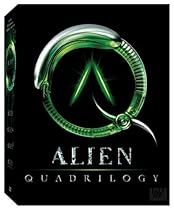 19. ALIEN (1979). There is not much about this film that labels it as a chick flick, but it does feature Sigourney Weaver as Warrant Officer Ripley, the character who once and for all over-turned the cliche of women as helpless screaming victims in monster movies. That should be enough to get your girlfriend to sit through the chest-burster and other horrors on display.
19. ALIEN (1979). There is not much about this film that labels it as a chick flick, but it does feature Sigourney Weaver as Warrant Officer Ripley, the character who once and for all over-turned the cliche of women as helpless screaming victims in monster movies. That should be enough to get your girlfriend to sit through the chest-burster and other horrors on display.
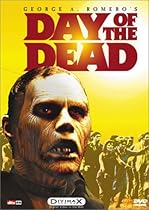 20. DAY OF THE DEAD(1985). This last title is really pushing it, but we think you deserve something in return for making the effort to find common ground with your squeamish main squeeze. After sitting through all those Gothic Romances, subtle ghost stories, and psychological terror tales, you want some gruesome gore, right? Well, this film from writer-director George Romero is just the thing: it’s brimming with blood, but it also has a strong female character in the lead, Lori Cardilel as Sarah. Inverting the formula of NIGHT OF THE LIVING DEAD, in which Barbra (Judith O’Dea) was pretty much a useless space case, Romero makes Sarah the only one who can keep her shit together while humanity totters on the brink of extinction. That may not make it a chick flick, but it should offer at least a little redeeming value for making the love your life watch a man ripped in half by cannibalistic zombies.
20. DAY OF THE DEAD(1985). This last title is really pushing it, but we think you deserve something in return for making the effort to find common ground with your squeamish main squeeze. After sitting through all those Gothic Romances, subtle ghost stories, and psychological terror tales, you want some gruesome gore, right? Well, this film from writer-director George Romero is just the thing: it’s brimming with blood, but it also has a strong female character in the lead, Lori Cardilel as Sarah. Inverting the formula of NIGHT OF THE LIVING DEAD, in which Barbra (Judith O’Dea) was pretty much a useless space case, Romero makes Sarah the only one who can keep her shit together while humanity totters on the brink of extinction. That may not make it a chick flick, but it should offer at least a little redeeming value for making the love your life watch a man ripped in half by cannibalistic zombies.
If you are interested in the films on this list, most of them are reviewed more fully elsewhere on the website. You can access the reviews by clicking on the titles that contain hyperlinks.
NOTE: Yes, this article makes sexist assumptions about what constitutes a “chick flick,” and we know that some women do not like the term – an issue we addressed in this previous editorial.
UPDATE (04/27/08): We have received some suggestions for titles we overlooked:
- Lucius Gore of Eplatter recommends SCREAM. I suppose the combination of humor and a strong “Final Girl” character would appeal to women more than a standard slasher movie.
- Brian Collins of Horror Movie a Day recommends GINGER SNAPS.
- Jeff Allard of Dinner with Max Jenke believes that ALIENS has a greater female appeal than ALIEN, which makes sense, considering the maternal themes in the film. He also recommends ROSEMARY’S BABY – which is such an obvious choice that I am embarrassed to have overlooked it. Roman Polanski’s adaptation of the Ira Levin novel is considered to be one of the greatest horror movies ever made (EXORCIST director William Friedkin puts it on his very short list here), and it’s all about a young married woman (Mia Farrow)undergoing her first pregnancy. Yes, we all know she is going to give birth to the spawn of Satan – or is she? The film actually delivers little-to-no evidence on this score except the professed belief of the Satanic cult (we’re supposed to trust them?). In a way, the movie plays out as a drama about a woman undergoing a trouble pregnancy, who is betrayed by her husband, and bedeviled by some kooky neighbors. In othe words, it is very much set in the real world, and features a situation that is completely relatable; even if the details are extreme, almost any woman could watch this movie and identify with what poor Rosemary is suffering.
UPDATE (01/28/09): Someone on an IMDB message board thread, linking to this article, suggested that THE DESCENT should have made the list.
